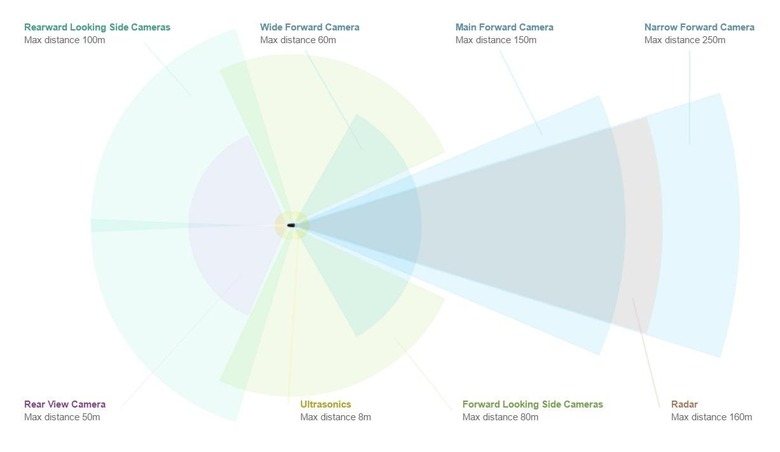Tesla's Autopilot 2.0 Lawsuit Settlement Is One Step Closer [Updated]
A Tesla Autopilot class action suit is one step closer to settlement, with Model S and Model X owning plaintiffs agreeing to a cash payout having complained that the second-generation of the driver assistance technology had delays in its functionality being rolled out. The agreement, which is yet to be approved by the San Jose federal court judge overseeing the case, would see more than $5m being set aside for a settlement fund by Tesla.
The complaint followed Tesla's switch to Autopilot 2.0 back in October 2016, the second generation of its driver-assistance technology. That dramatically increased the number of sensors installed on the car, and the automaker promised that functionality would significantly improve in tandem. Indeed, Tesla even suggested that – eventually – Autopilot 2.0 cars would be capable of fully autonomous driving.
The "Enhanced Autopilot" 2.0 package on the Model S and Model X was priced at $5,000, while a further $3,000 secured the "Fully Self-Driving" package for the future autonomous updates. However the actual semiautonomous Autopilot experience when the cars were delivered proved to be far from the slick system Tesla had been describing. In fact, Autopilot 2.0 lacked many of the features that Autopilot 1.0 was offering.

Adaptive cruise control wasn't initially enabled, nor speed assist or park assist. There was no Autosteer, Autopark, or automatic lane-changing. Even basics, like automatic windshield wipers, auto headlamp dimming, and other core features were missing when the first Autopilot 2.0 cars were delivered.
It was the absence of some of the more typical active safety features, such as blind spot detection, forward collision warnings, automatic emergency braking, side collision warnings and avoidance, and lane-departure warnings that proved the final straw for owners. A group of disgruntled EV drivers ganged together, filing a lawsuit alleging that Tesla had been slow to deliver the firmware updates required to enable the functionality it was promising. Without them, the group argued, Autopilot was "essentially unusable and demonstrably dangerous," Reuters reports.
The problem was Tesla's sudden split from computer vision specialist MobilEye, hardware and software from which had been powering some of the first generation Autopilot systems. Without that expertise, Tesla had to develop its own software for Autopilot 2.0, and it turned out to be tougher than the automaker expected. The original timeline, to have Autopilot 2.0 reach feature-parity with its predecessor, was set for December 2016.
Tesla just slipped under the wire with a partial roll-out of features by the end of 2016, but true feature-parity still took many months more. Automatic emergency braking, for instance, arrived on Autopilot 2.0 cars in April 2017. Even now, the system cannot do the Smart Summon feature that Tesla still bills as an Autopilot 2.0 feature, with the car navigating around more complex environments and parking garages to find its owner.
News of the settlement began several weeks ago, with the plaintiffs filing their approval brief this week. In a statement, Tesla said that the settlement fund will be distributed in different amounts, depending on when their car was purchased and delivered, taking into account the timeline of the Hardware 2 updates. It also confirmed that, though the settlement was US specific, it plans to also extend compensation to all affected customers worldwide.
"Since rolling out our second generation of Autopilot hardware in October 2016, we have continued to provide software updates that have led to a major improvement in Autopilot functionality. This has included an extensive overhaul of the underlying architecture of our Autopilot software that enabled a step-change improvement in its machine learning capabilities. Our neural net, which expands as our customer fleet grows, is able to collect and analyze more high-quality data than ever before, which will enable us to roll out a series of new Autopilot features in 2018 and beyond. The customer response to our recent Autopilot updates has been overwhelmingly positive, so we know we're on the right track.
That said, as time passed since we first unveiled Hardware 2, it eventually became clear that it was taking us longer to roll out these features than we would have liked or initially expected. We want to do right by those customers, so as part of a proposed settlement agreement for a class action lawsuit filed last year, we've agreed to compensate customers who purchased Autopilot on Hardware 2 vehicles who had to wait longer than we expected for these features. If the settlement is approved by the court, customers will receive different amounts depending on when they purchased and took delivery of their cars. Although the settlement is specific to customers in the US, if it is approved by the court, we've decided to compensate all customers globally in the same way. There's no legal obligation to do so, but it's the right thing to do."
Update: The original class action complaint, filed in 2017 [pdf], describes Autopilot as delivered as "dangerous" but, sources familiar with the agreement confirm to us, the settlement both sides have agreed to is specific only to the claims that Tesla took longer than promised to bring Autopilot to market. Tesla has denied it intended to defraud Model S and Model X buyers, and is not settling on those claims. We've updated our article accordingly. The actual settlement agreement is yet to be released publicly.
